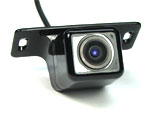Fitting a Reversing Camera Kit
Fitting an Aftermarket Reversing Camera System
How does a Reversing Camera System work?
The camera is placed at the back of the vehicle with a display screen on the inside, visible to the driver; the camera and display screen show the driver live images from the rear of the car. Reversing Camera Kits makes reversing into small spaces much easier and shows obstructions that may not be visible in the mirrors. Reversing Camera Kits are now available for vehicles that did not come with a reversing camera fitted as standard. This guide will help you to understand some of the options available, and how they can be fitted to your car, van or truck.
Reversing cameras come in all shapes and sizes - which one to choose depends on your vehicle and personal preferences, but ideally they should be as unobtrusive as possible, and provide a clear view behind you. Find our full list of Reversing Camera Kits here
Where to fit the rear view camera
The location of your camera should be low down and on the central point of the vehicle, ideally the middle of your rear bumper. You can find an aftermarket camera designed specifically for your vehicle, these work by replacing a number plate light fitting or rear light cluster to a subtle look. Some cameras come with built in LED lights as they're bright and draw very little power. A must have if you park somewhere without street lights, or your built in reversing lights are poor.
Universal cameras are either embedded in plastic, metal bodywork or attached to a suitable mounting point. Embedded cameras are less prone to damage, but you may need to create a hole to fit them. If cutting a hole in your car sounds a bit daunting, an easier alternative is a exterior mounted rear view camera; they can be attached with screws, high strength adhesive pads or other means to make them removable.
Power supply for Camera
The power for the Reversing Camera will come from a separate box that is wired to the camera, or a cable that feeds directly to the camera itself. The best way to power these is from the 12V power supply to the reversing light so when you engage reverse, the reversing light bulb comes on AND the camera gets power at the same time
If your camera has replaced a rear light unit, you may need to reconnect it to the power supply for that rear light; so the light is turned on appropriately. For example if a Reversing Camera replaced a number plate light, it will need to have power when the dipped or main lights are on.
Choose Your Display
If you already have a built in Sat-Nav or a car entertainment screen, you may have a spare input that you can connect the camera to. Even if you don't, you may be able to use an additional wiring harness to allow multiple inputs. If you do not have an existing screen, you'll need to get an LCD display screen that can be attached to your dashboard. The add on screen will require power which can be taken from any 12V power supply (Radio connectors can be used)
Tips for Choosing a Reversing Camera System
- If your existing screen only accepts PAL or NTSC signals, ensure the camera outputs in a suitable format. Our rear view cameras output in either format for compatibility.
- Wide angle cameras give a wider viewing angle and can be more useful. 120 degrees or more gives a excellent view, but cameras with smaller viewing angles are still useful if mounted higher on the vehicle.
- A rear view camera with additional LED lighting is a must have for parking at night.All our cameras also have a night vision mode for low light levels.
- Always make sure the camera is waterproof! Its best to use one specifically designed for vehicles.
You can find a list on our range of Reverse Parking kits here





